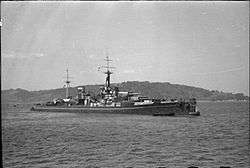Fleet tender
Fleet tenders were British merchant ships that were fitted with a wooden superstructure to resemble battleships or aircraft carriers during the Second World War. They were built to fool German reconnaissance planes, and known as fleet tenders to conceal their purpose.
Three ships were converted in 1939[1] and another, HMS Centurion, in 1941. The three converted in 1939 were 7,900-tons merchant ships:
- SS Pakeha, fleet tender A, as HMS Revenge
- ASS Waimana, fleet tender B, as HMS Resolution
- SS Mamari, fleet tender C, as carrier HMS Hermes
These three ships never left the home waters of the United Kingdom, and became obsolete in 1941. SS Mamari was wrecked off The Wash and then attacked by German torpedo boats. SS Pakeha and SS Waimana were converted back to merchants and returned to cargo use, but as the Empire Pakeha and Empire Waimana under the Ministry of War Transport[2]
HMS Centurion was a First World War-era battleship, disarmed under the Washington Naval Treaty. In May 1941 she was fitted with a dummy after-funnel, mainmast and main armament, to resemble the modern HMS Anson.[3] She left home waters to sail around the Cape of Good Hope to Bombay, and in June 1942 acted as a decoy in a convoy to Malta (operation Vigorous). HMS Centurion was used as a blockship off the Normandy coast as part of the Gooseberry shelter for Omaha Beach.

_at_Devonport%2C_March_1945.jpg)

Notes
- ↑ Donald A. Bertke; Gordon Smith; Don Kindell (1 March 2011). WORLD WAR TWO SEA WAR. Lulu.com. pp. 210–. ISBN 978-0-578-02941-2. Entry for 21 November 1939
- ↑ http://www.mariners-l.co.uk/EmpireU.html#empw
- ↑ "HMS CENTURION REFIT TO ACT AS THE DOUBLE FOR HMS ANSON MAY 1941 HER AFT FUNNEL AND GUN TURRETS ARE DUMMIES (A 9983)". Imperial War Museum. Retrieved 4 May 2016.
References
- Now It Can Be Told! - How the Navy's Phantom Fleet Hoaxed the Hun, The War Illustrated, September 14, 1945.